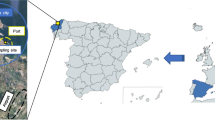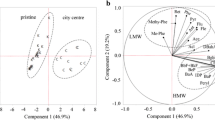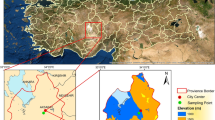Abstract
The research intended to find the atmospheric concentrations, sources, and health risks of 16 particle-phase polycyclic aromatic hydrocarbons (PAHs) at the Indo Gangetic Plain (IGP) outflow location for the first time. A total of thirty-six samples of total suspended particulate (TSP) matters were collected with a low volume sampler on quartz filters. PAHs were extracted from filters with dichloromethane (DCM) while purification processes were conducted using solid-phase extraction (SPE) and concentrations of PAHs were determined by gas chromatography coupled with mass spectrometry (GC-MS). The summation of the yearly average values for the total PAHs concentrations was 58.8 ng m-3; meanwhile, the highest concentration for the total PAHs was obtained during winter (81.26 ng m-3), whereas the lowest was on monsoon (15.52 ng m-3) illustrates strong seasonal variations. The effect of transboundary pollution was significant during the winter season. Moreover, the five rings PAHs contributed significantly (54.0%) compared to others. In addition, diagnostic ratio analysis preliminary pointed out that most of the PAHs were emitted from fuel oil and biomass combustion. Furthermore, the PMF model revealed that the sources of PAHs were gasoline exhaust (25%), diesel engine combustion (30%), natural gas emission (23%), and biomass burning (22%). The Bnz(a)Peq factor of individual PAHs varies between 8.0×10-4 ng m-3 [Phenanthrene] and 5.70 ng m-3 [Benzo(a)pyrene] with a summation of 13.34 ng m-3 for total. The cancer risk of total PAHs was 11.6 times higher than the European Union (EU) guideline value.







Similar content being viewed by others
Data availability
The raw datasets analyzed during the current study are available from the corresponding author on reasonable request.
References
Ahmed M, Hossain A, Akther T et al (2018) Chemical composition and source identification of fog water at an indo-gangetic plain (IGP) Outflow location (Coastal Bhola Island), Bangladesh. J Environ Pollut Manag 1:1–9
Alam MS, Delgado-Saborit JM, Stark C, Harrison RM (2013) Using atmospheric measurements of PAH and quinone compounds at roadside and urban background sites to assess sources and reactivity. Atmos Environ 77:24–35
Baumann K, Jayanty RKM, Flanagan JB (2008) Fine particulate matter source apportionment for the chemical speciation trends network site at Birmingham, Alabama, using positive matrix factorization. J Air Waste Manage Assoc 58:27–44. https://doi.org/10.3155/1047-3289.58.1.27
Bosetti C, Boffetta P, La Vecchia C (2007) Occupational exposures to polycyclic aromatic hydrocarbons, and respiratory and urinary tract cancers: a quantitative review to 2005. Ann Oncol 18:431–446. https://doi.org/10.1093/annonc/mdl172
Callén MS, López JM, Iturmendi A, Mastral AM (2013) Nature and sources of particle associated polycyclic aromatic hydrocarbons (PAH) in the atmospheric environment of an urban area. Environ Pollut 183:166–174. https://doi.org/10.1016/j.envpol.2012.11.009
Dickhut RM, Canuel EA, Gustafson KE, Liu K, Arzayus KM, Walker SE, Edgecombe G, Gaylor MO, MacDonald EH (2000) Automotive sources of carcinogenic polycyclic aromatic hydrocarbons associated with particulate matter in the Chesapeake Bay region. Environ Sci Technol 34:4635–4640. https://doi.org/10.1021/es000971e
Draxler RR, Hess GD (1998) An overview of the HYSPLIT_4 modelling system for trajectories, dispersion and deposition. Aust Meteorol Mag 47:295–308
Du W, Yun X, Chen Y et al (2020) PAHs emissions from residential biomass burning in real-world cooking stoves in rural China. Environ Pollut 267:115592. https://doi.org/10.1016/j.envpol.2020.115592
European Commission (2001) Polycyclic Aromatic Hydrocarbons (PAH) Position Paper (July 2001) (Prepared by the Working Group on Polycyclic Aromatic Hydrocarbons)
European Union (EU) (2008) Directive 2008/50/EC of the European Parliament and of the Council of 21 May 2008 on Ambient Air Quality and Cleaner Air for Europe (OJ L 152, 11.6.2008):1–44
Fleming ZL, Monks PS, Manning AJ (2012) Review: untangling the influence of air-mass history in interpreting observed atmospheric composition. Atmos Res 104–105:1–39. https://doi.org/10.1016/j.atmosres.2011.09.009
Fraser MP, Yue ZW, Tropp RJ, Kohl SD, Chow JC (2002) Molecular composition of organic fine particulate matter in Houston, TX. Atmos Environ 36:5751–5758. https://doi.org/10.1016/S1352-2310(02)00725-2
Grmasha RA, Al-sareji OJ, Salman JM, Hashim KS (2020) Polycyclic aromatic hydrocarbons (PAHs) in urban street dust within three land-uses of Babylon governorate, Iraq: Distribution, sources, and health risk assessment. J King Saud Univ Eng Sci. https://doi.org/10.1016/j.jksues.2020.11.002
Guo Z, Lin T, Zhang G, Hu L, Zheng M (2009) Occurrence and sources of polycyclic aromatic hydrocarbons and n-alkanes in PM2.5 in the roadside environment of a major city in China. J Hazard Mater 170:888–894. https://doi.org/10.1016/j.jhazmat.2009.05.051
Han B, Liu A, He S, Li Q, Zheng L (2020) Composition, content, source, and risk assessment of PAHs in intertidal sediment in Shilaoren Bay, Qingdao, China. Mar Pollut Bull 159:111499. https://doi.org/10.1016/j.marpolbul.2020.111499
Hanedar A, Alp K, Kaynak B, Avşar E (2014) Toxicity evaluation and source apportionment of Polycyclic Aromatic Hydrocarbons (PAHs) at three stations in Istanbul, Turkey. Sci Total Environ 488–489:437–446. https://doi.org/10.1016/j.scitotenv.2013.11.123
Harrison RM, Beddows DCS, Dall’Osto M (2011) Erratum: PMF analysis of wide-range particle size spectra collected on a major highway (Environmental Science & Technology (2011) 45 (5522-5528) DOI: 10.1021/es2006622). Environ Sci Technol 45:6215. https://doi.org/10.1021/es201998m
Jamhari AA, Sahani M, Latif MT, Chan KM, Tan HS, Khan MF, Mohd Tahir N (2014) Concentration and source identification of polycyclic aromatic hydrocarbons (PAHs) in PM10 of urban, industrial and semi-urban areas in Malaysia. Atmos Environ 86:16–27. https://doi.org/10.1016/j.atmosenv.2013.12.019
Khalili NR, Scheff PA, Holsen TM (1995) PAH source fingerprints for coke ovens, diesel and, gasoline engines, highway tunnels, and wood combustion emissions. Atmos Environ 29:533–542. https://doi.org/10.1016/1352-2310(94)00275-P
Khan MF, Latif MT, Lim CH, Amil N, Jaafar SA, Dominick D, Mohd Nadzir MS, Sahani M, Tahir NM (2015) Seasonal effect and source apportionment of polycyclic aromatic hydrocarbons in PM2.5. Atmos Environ 106:178–190. https://doi.org/10.1016/j.atmosenv.2015.01.077
Khan MF, Latif MT, Saw WH, Amil N, Nadzir MSM, Sahani M, Tahir NM, Chung JX (2016) Fine particulate matter in the tropical environment: Monsoonal effects, source apportionment, and health risk assessment. Atmos Chem Phys 16:597–617. https://doi.org/10.5194/acp-16-597-2016
Khan MF, Maulud KNA, Latif MT, Chung JX, Amil N, Alias A, Nadzir MSM, Sahani M, Mohammad M, Jahaya MF, Hassan H, Jeba F, Tahir NM, Abdullah SMS (2018) Physicochemical factors and their potential sources inferred from long-term rainfall measurements at an urban and a remote rural site in tropical areas. Sci Total Environ 613-614:1401–1416
Kulkarni P, Venkataraman C (2000) Atmospheric polycyclic aromatic hydrocarbons in Mumbai, India. Atmos Environ 34:2785–2790. https://doi.org/10.1016/S1352-2310(99)00312-X
Landrigan PJ, Fuller R, Acosta NJR, Adeyi O, Arnold R, Basu N(N), Baldé AB, Bertollini R, Bose-O'Reilly S, Boufford JI, Breysse PN, Chiles T, Mahidol C, Coll-Seck AM, Cropper ML, Fobil J, Fuster V, Greenstone M, Haines A, Hanrahan D, Hunter D, Khare M, Krupnick A, Lanphear B, Lohani B, Martin K, Mathiasen KV, McTeer MA, Murray CJL, Ndahimananjara JD, Perera F, Potočnik J, Preker AS, Ramesh J, Rockström J, Salinas C, Samson LD, Sandilya K, Sly PD, Smith KR, Steiner A, Stewart RB, Suk WA, van Schayck OCP, Yadama GN, Yumkella K, Zhong M (2018) The Lancet Commission on pollution and health. Lancet 391:462–512. https://doi.org/10.1016/S0140-6736(17)32345-0
Larsen RK, Baker JE (2003) Source apportionment of polycyclic aromatic hydrocarbons in the urban atmosphere: a comparison of three methods. Environ Sci Technol 37:1873–1881. https://doi.org/10.1021/es0206184
Lee JH, Gigliotti CL, Offenberg JH, Eisenreich SJ, Turpin BJ (2004) Sources of polycyclic aromatic hydrocarbons to the Hudson River Airshed. Atmos Environ 38:5971–5981. https://doi.org/10.1016/j.atmosenv.2004.07.004
Liu Y, Chen L, Hui HQ et al (2009) Source apportionment of polycyclic aromatic hydrocarbons (PAHs) in surface sediments of the Huangpu River, Shanghai, China. Sci Total Environ 407:2931–2938. https://doi.org/10.1016/j.scitotenv.2008.12.046
Ma L, Li B, Liu Y, et al (2020) Characterization , sources and risk assessment of PM 2 . 5 -bound polycyclic aromatic hydrocarbons ( PAHs ) and nitrated PAHs ( NPAHs ) in Harbin , a cold city in Northern China. 264. https://doi.org/10.1016/j.jclepro.2020.121673
Manoli E, Kouras A, Samara C (2004) Profile analysis of ambient and source emitted particle-bound polycyclic aromatic hydrocarbons from three sites in northern Greece. Chemosphere 56:867–878. https://doi.org/10.1016/j.chemosphere.2004.03.013
Masih J, Dyavarchetty S, Nair A, Taneja A, Singhvi R (2019) Concentration and sources of fine particulate associated polycyclic aromatic hydrocarbons at two locations in the western coast of India. Environ Technol Innov 13:179–188. https://doi.org/10.1016/j.eti.2018.10.012
Nisbet ICT, LaGoy PK (1992) Toxic equivalency factors (TEFs) for polycyclic aromatic hydrocarbons (PAHs). Regul Toxicol Pharmacol 16 (3):290–300
Ogulei D, Hopke PK, Wallace LA (2006a) Analysis of indoor particle size distributions in an occupied townhouse using positive matrix factorization. Indoor Air 16:204–215. https://doi.org/10.1111/j.1600-0668.2006.00418.x
Ogulei D, Hopke PK, Zhou L, Patrick Pancras J, Nair N, Ondov JM (2006b) Source apportionment of Baltimore aerosol from combined size distribution and chemical composition data. Atmos Environ 40:396–410. https://doi.org/10.1016/j.atmosenv.2005.11.075
Park SS, Kim YJ, Kang CH (2002) Atmospheric polycyclic aromatic hydrocarbons in Seoul, Korea. Atmos Environ 36:2917–2924. https://doi.org/10.1016/S1352-2310(02)00206-6
Park SU, Kim JG, Jeong MJ, Song BJ (2011) Source identification of atmospheric polycyclic aromatic hydrocarbons in industrial complex using diagnostic ratios and multivariate factor analysis. Arch Environ Contam Toxicol 60:576–589. https://doi.org/10.1007/s00244-010-9567-5
Petry T, Schmid P, Schlatter C (1996) The use of toxic equivalency factors in assessing occupational and environmental health risk associated with exposure to airborne mixtures of polycyclic aromatic hydrocarbons (PAHs). Chemosphere 32(4):639–648. https://doi.org/10.1016/0045-6535(95)00348-7
Puxbaum H, Rendl J, Allabashi R, Otter L, Scholes MC (2000) Mass balance of the atmospheric aerosol in a South African subtropical savanna (Nylsvley, May 1997). J Geophys Res Atmos 105:20697–20706. https://doi.org/10.1029/2000JD900306
Ramadan Z, Song XH, Hopke PK (2000) Identification of sources of Phoenix aerosol by positive matrix factorization. J Air Waste Manag Assoc 50(8):1308–1320
Ramírez N, Cuadras A, Rovira E, Marcé RM, Borrull F (2011) Risk assessment related to atmospheric polycyclic aromatic hydrocarbons in gas and particle phases near industrial sites. Environ Health Perspect 119:1110–1116. https://doi.org/10.1289/ehp.1002855
Ravindra K, Bencs L, Wauters E, de Hoog J, Deutsch F, Roekens E, Bleux N, Berghmans P, van Grieken R (2006) Seasonal and site-specific variation in vapour and aerosol phase PAHs over Flanders (Belgium) and their relation with anthropogenic activities. Atmos Environ 40:771–785. https://doi.org/10.1016/j.atmosenv.2005.10.011
Ravindra K, Dirtu AC, Mor S, Wauters E, van Grieken R (2020) Source apportionment and seasonal variation in particulate PAHs levels at a coastal site in Belgium. Environ Sci Pollut Res 27:14933–14943. https://doi.org/10.1007/s11356-020-07881-7
Salam A, Bauer H, Kassin K, Mohammad Ullah S, Puxbaum H (2003) Aerosol chemical characteristics of an island site in the Bay of Bengal (Bhola - Bangladesh). J Environ Monit 5:483–490. https://doi.org/10.1039/b212521h
Salam MA, Shirasuna Y, Hirano K, Masunaga S (2011) Particle associated polycyclic aromatic hydrocarbons in the atmospheric environment of urban and suburban residential area. Iran J Environ Health Sci Eng 8:255–266
Salam A, Ullah MB, Islam MS, Salam MA, Ullah SM (2013) Carbonaceous species in total suspended particulate matters at different urban and suburban locations in the Greater Dhaka region, Bangladesh. Air Qual Atmos Health 6:239–245. https://doi.org/10.1007/s11869-011-0166-z
Sarkar S, Khillare PS (2013) Profile of PAHs in the inhalable particulate fraction: source apportionment and associated health risks in a tropical megacity. Environ Monit Assess 185:1199–1213. https://doi.org/10.1007/s10661-012-2626-9
Shohel M, Kistler M, Rahman MA, Kasper-Giebl A, Reid JS, Salam A (2018) Chemical characterization of PM2.5 collected from a rural coastal island of the Bay of Bengal (Bhola, Bangladesh). Environ Sci Pollut Res 25:4558–4569. https://doi.org/10.1007/s11356-017-0695-6
Stein AF, Draxler RR, Rolph GD, Stunder BJB, Cohen MD, Ngan F (2015) Noaa’s hysplit atmospheric transport and dispersion modeling system. Bull Am Meteorol Soc 96:2059–2077. https://doi.org/10.1175/BAMS-D-14-00110.1
Sun F, Littlejohn D, David Gibson M (1998) Ultrasonication extraction and solid phase extraction clean-up for determination of US EPA 16 priority pollutant polycyclic aromatic hydrocarbons in soils by reversed-phase liquid chromatography with ultraviolet absorption detection. Anal Chim Acta 364:1–11. https://doi.org/10.1016/S0003-2670(98)00186-X
Tobiszewski M, Namieśnik J (2012) PAH diagnostic ratios for the identification of pollution emission sources. Environ Pollut 162:110–119. https://doi.org/10.1016/j.envpol.2011.10.025
USEPA Environmental Protection Agency (2008) EPA positive matrix factorization (PMF) 3.0 fundamentals and user guide. In: Norris G, Vedantham R, Wade K, Brown S, Prout J, Foley C, editors. Washington, DC: U.S. Environmental Protection Agency Office of Research and Development
US-EPA (2014) EPA Positive M atrix Factorization (PM F) 5.0 Fundamentals and. Environ Prot Agency Off Researc Dev Publushing House Whashington, DC 20460 136
Venkataraman C, Friedlander SK (1994) Size distribution of polycyclic aromatic hydrocarbons and elemental carbon. 1: Ambient measurements and effects of atmospheric processes. Environ Sci Technol 28:563–572
World Health Organization (WHO) (1987) Air Quality Guidelines for Europe. WHO Regional Publication, European Series No. 23. World Health Organization, Copenhagen
World Health Organization (WHO) (2000) Air Quality Guidelines for Europe. Second edition. WHO Regional Publications, European Series No. 91. World Health Organization, Copenhagen
Xing W, Zhang L, Yang L, Zhou Q, Zhang X, Toriba A, Hayakawa K, Tang N (2020) Characteristics of PM2.5-bound polycyclic aromatic hydrocarbons and nitro-polycyclic aromatic hydrocarbons at a roadside air pollution monitoring station in Kanazawa, Japan. Int J Environ Res Public Health 17:1–11. https://doi.org/10.3390/ijerph17030805
Yang HH, Chen CM (2004) Emission inventory and sources of polycyclic aromatic hydrocarbons in the atmosphere at a suburban area in Taiwan. Chemosphere 56:879–887. https://doi.org/10.1016/j.chemosphere.2004.05.031
Yunker MB, Macdonald RW, Vingarzan R, Mitchell RH, Goyette D, Sylvestre S (2002) Yunker-2002-PAHs in the Fraser R.pdf. Org Geochem 33:489–515
Zhao T, Yang L, Huang Q, Zhang W, Duan S, Gao H, Wang W (2020) Science of the total environment (NPAHs) emitted by gasoline vehicles : characterization and health risk assessment. Sci Total Environ 727:138631. https://doi.org/10.1016/j.scitotenv.2020.138631
Zhu Y, Yang L, Yuan Q, Yan C, Dong C, Meng C, Sui X, Yao L, Yang F, Lu Y, Wang W (2014) Airborne particulate polycyclic aromatic hydrocarbon (PAH) pollution in a background site in the North China Plain: concentration, size distribution, toxicity and sources. Sci Total Environ 466–467:357–368. https://doi.org/10.1016/j.scitotenv.2013.07.030
Acknowledgements
Authors thank to Md Nazrul Islam, Bangladesh Climate Observatory, Bhola (BCOB) for helping with particulate matter sampling, Md Firoz Khan acknowledges research support from Universiti Malaya (UM),UM Living Lab Grant LL058-2021, the University Kebangsaan Malaysia for helping with chemical analysis and supporting travel expenses for Farah Jeba, and the NOAA for supporting HYSPLIT Model calculation of backward air mass trajectory.
Funding
University Kebangsaan Malaysia for travel and chemical analysis by UKM Research University Grant (GUP-2018-2019).
Author information
Authors and Affiliations
Contributions
Farah Jeba: preserving the samples, chemical analysis, writing the manuscript, and reviewing and editing. Tanzina Tul Karim: writing the manuscript and reviewing and editing. Md. Firoz Khan: continuous monitoring during chemical analysis and reviewing the manuscript and editing. Mohd. Talib Latif: planning, providing instruments and chemicals for chemical analysis reviewing the manuscript and editing. Kazi Fahad Quddus: all the modellings and software-related graphical representations and reviewing and editing. Abdus Salam: overall planning, providing sampling instruments and materials, and writing and editing.
Corresponding author
Ethics declarations
Ethics approval
Not applicable—no human or animal subject used.
Consent to participate
Not applicable.
Consent for publication
All the co-authors agreed to publish this manuscript.
Competing interests
The authors declare no competing interests.
Additional information
Publisher’s note
Springer Nature remains neutral with regard to jurisdictional claims in published maps and institutional affiliations.
Supplementary Information
ESM 1
(DOCX 24 kb)
Rights and permissions
About this article
Cite this article
Jeba, F., Karim, T.T., Khan, M.F. et al. Receptor modelling and risk factors of polycyclic aromatic hydrocarbons (PAHs) in the atmospheric particulate matter at an IGP outflow location (island of the bay of Bengal—Bhola, Bangladesh). Air Qual Atmos Health 14, 1417–1431 (2021). https://doi.org/10.1007/s11869-021-01031-9
Received:
Accepted:
Published:
Issue Date:
DOI: https://doi.org/10.1007/s11869-021-01031-9




